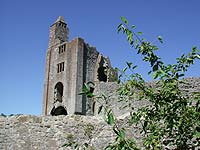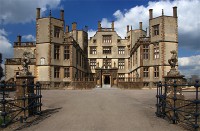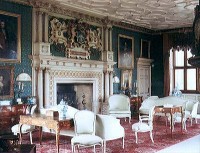If you’re in the Dorset area of southwest England, then it’s well worth scheduling a visit to the town of Sherborne – especially if you enjoy history and castles. Although only a relatively small town, it’s got not one, but two, ancient castles to explore – one ruined and one intact.
Sherborne Old Castle
 Located about ¾ of a mile outside the town centre, the old castle was built in the 12th century by Bishop Roger of Salisbury and was a key base during the Civil War. Sadly, much of the building was destroyed in 1645 by Cromwell’s troops, after a battle and siege lasting 11 days. As it was no longer usable as a building, the name Sherborne Castle was passed on to the newer building in the town – that is why there’s both an old and a new castle here.
Located about ¾ of a mile outside the town centre, the old castle was built in the 12th century by Bishop Roger of Salisbury and was a key base during the Civil War. Sadly, much of the building was destroyed in 1645 by Cromwell’s troops, after a battle and siege lasting 11 days. As it was no longer usable as a building, the name Sherborne Castle was passed on to the newer building in the town – that is why there’s both an old and a new castle here.
What’s left of the castle ruins are now managed by English Heritage and it’s open daily from April to November. Although it’s a ruin, there’s still plenty to see and some walls are still towering and solid overhead, the tower area, for instance. From here, you can get a good idea of what the original building was like and it offers a great glimpse into British history.
Unless you’re a member of English Heritage, there’s an entrance fee involved. Although the old castle is regarded as a separate entity from the new castle, it is possible to buy a joint ticket to be able to explore both the new and old castle grounds.
Sherborne New Castle
 The new Sherborne Castle also has a long history, having been built by Sir Walter Raleigh back in 1594. Originally called, Sherborne Lodge, the Tudor building consisted of four storeys, with hexagonal corner turrets.
The new Sherborne Castle also has a long history, having been built by Sir Walter Raleigh back in 1594. Originally called, Sherborne Lodge, the Tudor building consisted of four storeys, with hexagonal corner turrets.
After Sir Walter Raleigh was accused of treason and died, King James I allowed Sir John Digby to purchase the property and, since 1617, it’s been the stately home of the Digby family. They subsequently added on four distinctive wings to the house, but the original Tudor building remains at the core of the castle.
 The castle interior has been decorated with rooms reflecting various periods of history, including Tudor, Jacobean, Georgian and Victorian periods. Visitors can tour the castle and enjoy exploring the extensive rooms and beautiful collections of art, antiques and furniture.
The castle interior has been decorated with rooms reflecting various periods of history, including Tudor, Jacobean, Georgian and Victorian periods. Visitors can tour the castle and enjoy exploring the extensive rooms and beautiful collections of art, antiques and furniture.
The castle comes complete with 20 acres of landscaped gardens, including an impressive lake that was created in 1753 by Capability Brown. There are some lovely walks to enjoy around the lake and the planting in the grounds is spectacular all year round. Even if you choose not to visit both castles, you can still glimpse the ruins of the old one whilst wandering around the grounds of the newer castle.
Admission charges apply for the grounds and castle, although you can purchase a ticket just to wander around the grounds. There’s a set price (no concessions) for entrance to the ground only.


Comments